By the end of Q1, the Canadian economy had returned to or exceeded the pre-pandemic levels of most major economic indicators. The recovery from the COVID-19 pandemic continued for Q2 of 2022, as a result of the lifting of health restrictions and a return to pre-pandemic travel, which is expected to continue through the summer months. Further government spending announced in the spring is expected to provide additional tailwinds for GDP growth for the remainder of the year.
Inflation is forecast to hit 30-year highs in the near-term due to increases in energy and food prices and are forecast to remain elevated longer than previously expected. The Bank of Canada is set to continue raising rates through 2022 to a high of 3.25% for the target overnight rate, up substantially from the low of 0.25% at the end of 2021. These interest rate increases are a response to rising inflation and are expected to cool down the Canadian economy by the end of the year.
BC’s economy has more or less echoed the Canadian economy in terms of economic indicators and witnessed the second fastest provincial growth in the nation during Q2. However, BC is forecast to see slower growth near the end of 2022, as higher interest rates impact housing affordability and demand for new residential construction.
This article gives readers an update from Q1 2022 to Q2 2022 of selected economic indicators. The indicators discussed herein are both indicative and representative of the Canadian, BC, and regional economies.
Labour Market
The labour force refers to the supply (employees) and demand (employers) for labour. The number of labour force participants and the unemployment rate are indicators that highlight the material changes that took place in the labour market from Q1 2022 to Q2 2022.
COVID-19 Government Programs
The federal government initiated several programs to support employers and employees impacted by COVID-19. Currently, the Jobs and Growth Fund and the Large Employer Emergency Financing Facility (LEEFF) are available for employers. The Work Sharing Program was also extended from a maximum of 38 weeks to a maximum of 76 weeks and will be in effect until September 24, 2022.
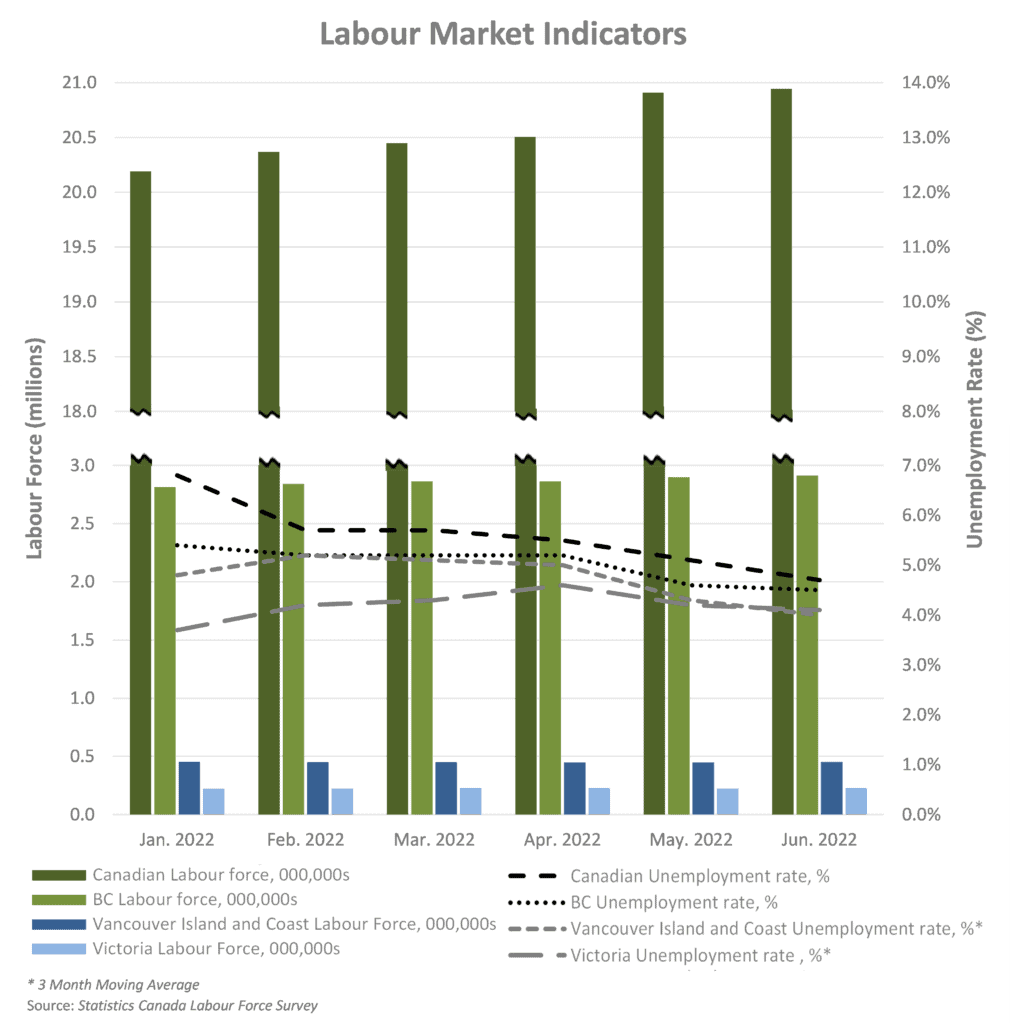
Labour Force
Before the impact of COVID-19, Canada experienced a steady increase in labour force participants. As of June 30, 2022, the Canadian labour force consisted of 20.9 million people, an increase of approximately 498,000 participants since the prior quarter and above the 20.0 million in the labour force prior to COVID-19.
Unemployment
The national unemployment rate was 5.7 % at the start of Q2 and decreased to 4.7% by the end of the quarter which is 1.2% lower than the pre-pandemic rate of 5.9%. TD Economics (TDE) forecasts that Canada’s unemployment will increase to 5.3% by the end of 2022 and then increase further to 5.8% for 2023.
BC’s unemployment rate decreased from 5.2% to 4.5% during Q2, reaching a three-year low. The quarter closing rate was 0.5% lower than the Province’s pre-COVID rate of 5.0%. BC’s demand for labour is the highest in the nation due to a strong economic recovery which has resulted in labour shortages. TDE forecasts BC’s unemployment rate to increase slightly to 4.8% for 2022, which is slightly higher than their Q1 forecast 4.6% for the year.
The unemployment rate for Vancouver Island and Coastal regions also decreased during Q2 from 5.1% to 4.0%, which was 1.3% lower than pre-pandemic rates. In Victoria, the unemployment rate decreased throughout the quarter from 4.3% to 4.1%, which has not yet reached the pre-pandemic rate of 3.5%.
Gross Domestic Product (GDP)
As posted in our prior update, TDE previously forecast Canada’s real GDP to grow by 3.9% for 2022. After Q2, TDE downgraded its 2022 GDP growth by 0.2% to 3.7%, due in part to lingering supply chain issues from the pandemic and the Ukraine war. TDE forecasts a further slowing of the national GDP growth rate to 1.7% for 2023.
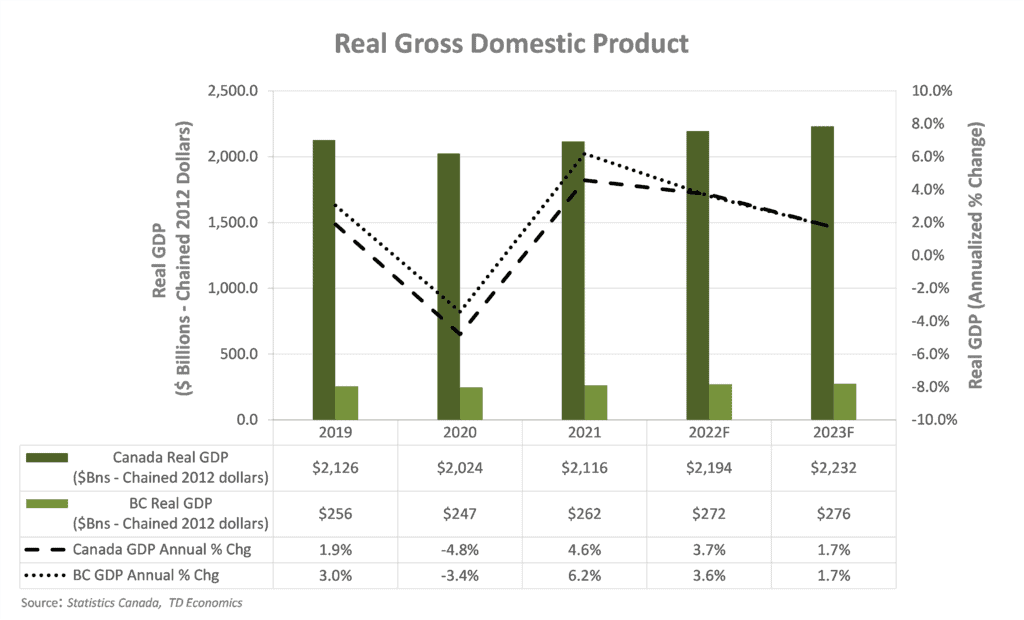
TDE also forecasts slower growth for the BC economy of 3.6% for 2022 which is also 0.2% lower than the forecast from the previous quarter (Q1 2021). The resulting forecast for BC’s GDP is $271.6 billion, $9.4 billion higher than that for 2021 and above pre-pandemic levels.
Housing Market
Housing starts and average residential prices reflect market indicators with strong correlation to both the construction and real estate industries. The residential housing market activity is forecast to continue decreasing as interest rates increase, worsening housing affordability.
BC’s housing starts increased by 26.2% during 2021, reversing months of consecutive declines. The BC Real Estate Association (BCREA) expects housing starts to moderate following years of robust new residential construction. BCREA forecasts a decrease in housing starts of 15.8% for 2022 followed by a further decrease of 2.7% for 2023 mainly due to the impact of recent interest rate increases on housing demand.
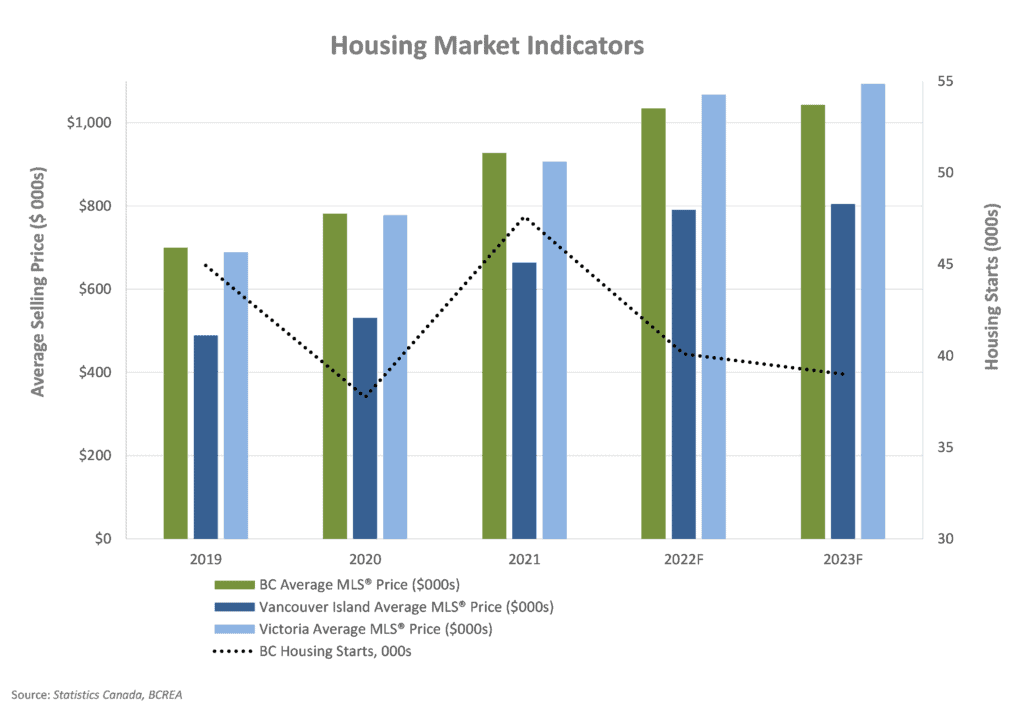
BCREA forecasts an increase of 11.5% in the BC average MLS® price for single family dwellings for 2022, with an average price of $1,034,400. This is notably larger than the prior quarter’s forecast for 2022, which predicted only an 8.5% increase with an average price of $1,006,000. BCREA attributes the forecast increase to a continued low level of supply (active listings).
Notwithstanding, BCREA downgraded their MLS® price growth forecast for 2023 from 2.7% to 0.8%, resulting in a higher average price of $1,042,900 next year. BCREA forecast an increase in the average MLS® prices for single family dwellings in the Victoria area of 17.8% for 2022 and 2.4% for 2023. BCREA predicts home sales will fall back to historically normal levels for rest of year due largely to rising interest rates.
Interest Rates & Foreign Exchange
During Q2 2022, the Bank of Canada (BoC) increased the overnight target rate from 0.5% last quarter to 1.5%. TDE forecasts that the target rate will continue to rise through 2022 and 2023.
The rising overnight target rate resulted in an increase in the prime rate. The average prime rate for Q2 was 3.7%, a 1.0% increase from the prior quarter. The prime rate is likely to continue increasing in step with the target overnight rate.

The BoC has stated that it will continue to increase policy rates to return inflation to the target of 2.00% from its recent high of 5.6% for Q1 2022. There is expected to be some lag in this process and TDE forecasts inflation to be 6.7% for 2022 before decreasing to 3.5% for 2023. Inflation increases in Canada can be attributed to Russia’s invasion of Ukraine, COVID-19 related lock-downs in China, and other supply disruptions.
The Q2 2022 forecast for the average annual USD to CAD exchange rate was $0.80 for 2022 and remain relatively constant at $0.78 for 2023. This exchange rate strongly correlates to oil prices, and over the long-term the value of the Canadian dollar relative to the US dollar typically fluctuates in-step with oil price changes.
Crude Oil Prices
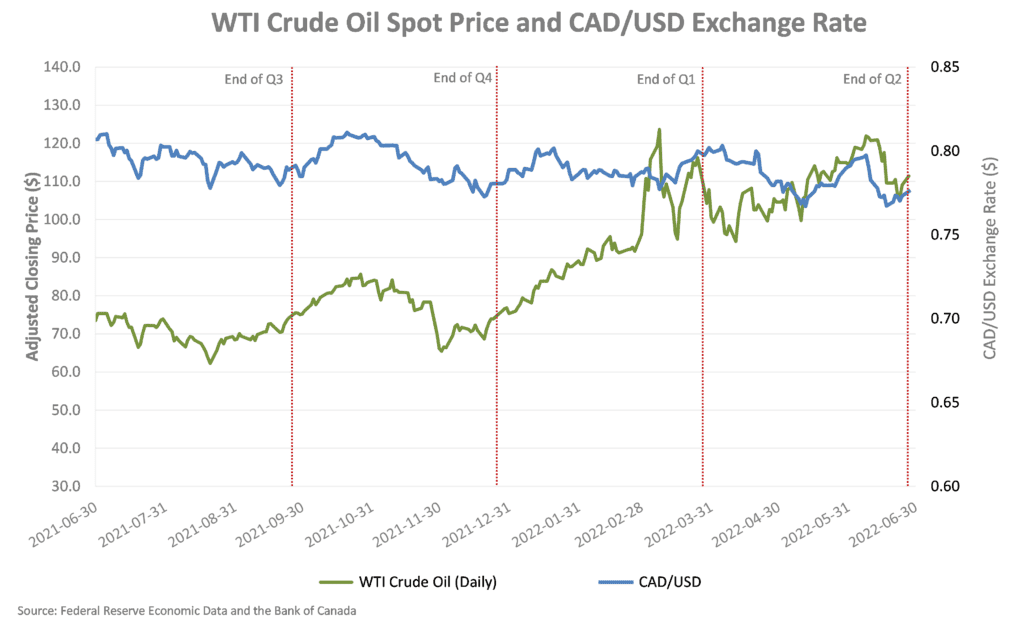
Canada has the fourth largest proven oil reserves in the world. As a net oil exporter, the Canadian economy is heavily impacted by the price of crude oil, with the greatest impact felt in Canada’s major oil producing provinces. The majority of Canadian crude oil production is in Alberta (81.0%), Saskatchewan (10.0%), and Newfoundland and Labrador (6.0%).
In North America, the West Texas Intermediate (WTI) crude oil spot price is the benchmark oil price. Historical WTI crude oil daily spot prices at the end of Q2 were:

Over the course of Q2, WTI oil prices spiked from $94.22 (April 11) to $121.94 (June 8) which is significantly higher than historical averages. The International Energy Agency (IEA) attributes the increase to international sanctions levied against Russia in response to its invasion of Ukraine. Russia is becoming more isolated after its invasion of Ukraine and tougher sanctions are being discussed which would fully phase out Russian imports. These anticipated sanctions could further impact the price of oil. TD Economics forecasts the WTI oil price to remain high at $106.00 per barrel for 2022 before decreasing to $92.50 for 2023.
Capital Markets
The international response to COVID-19 at the beginning of March 2020 negatively impacted the current and anticipated operations of many privately-owned and publicly traded North American businesses. For publicly traded companies, this impact is evident in changes in capital markets during the period. On March 12, 2020 both the Dow Jones Industrial Average (DJIA) and S&P/TSX Composite Index witnessed the greatest single-day percentage drop since the stock market crashes of 1943 and 1987, respectively. By the start of 2021 both indices had recovered to their pre-COVID-19 levels.
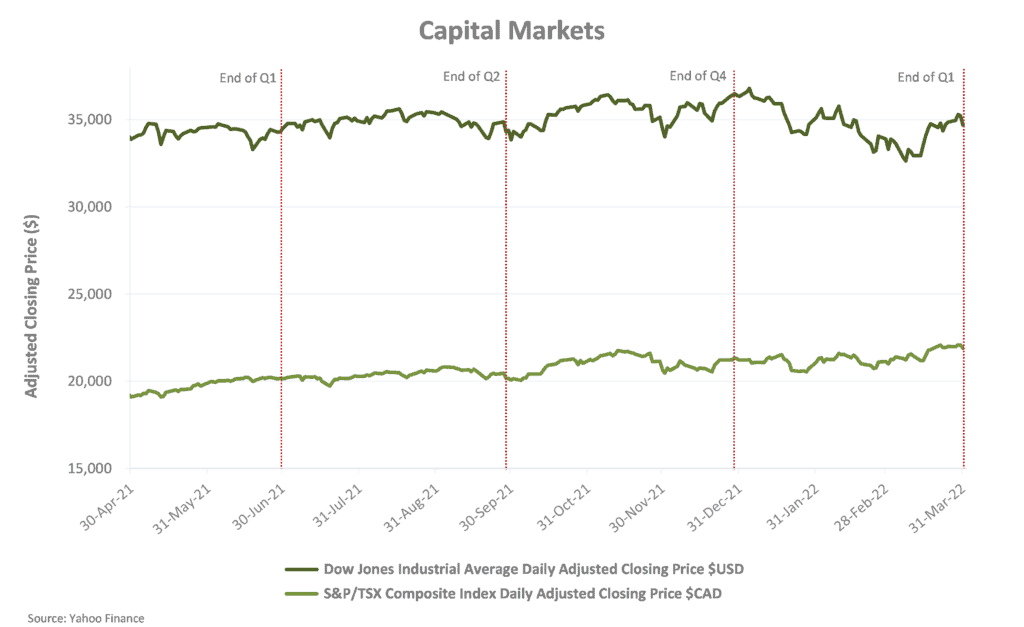
More recently, both the DJIA and S&P/TSX Composite indices reached all-time highs in Q1 2022: $36,800 (USD) on January 4, 2022, and $22,087 (CAD) on March 29, 2022, respectively. In Q2, the DJIA index reached a quarter high of $35,161 (USD) on April 20 and the S&P/TSX index reached a quarter high of $22,086 (CAD) on April 4, before trending downward to Q2 lows of $29,889 (USD) and $18,717 (CAD) for the DJIA and S&P/TSX indices, respectively, toward the end of the quarter, reaching index lows not seen since Q1 2021.
The year-to-date gain (loss) for both indices were -15.9% and -11.1%, respectfully, reversing over a year of growth, which has been attributed to mainly to recession fears. It is important to note that these indicators are based on forward looking assumptions and analysis.
Moving into third quarter of 2022, inflation is expected to reach new highs due to continued supply constraints, the impact of the Ukraine war, and high labour costs due to continued job vacancy rates. It is expected that high inflation will cause the BoC to continue increasing interest rates into the next quarter. COVID-19 restrictions are expected to remain lifted and vaccination rates to increase, especially with the release of the second booster shot in April 2022. Economic growth is forecast to continue slowing down in both the US and Canada. A recession is not yet anticipated; however, growth is expected to come close to stalling.
Some businesses may still be able to benefit from the fiscal stimulus provided by various levels of government, but higher input prices and labour costs are expected to stifle profit margins in many industries. However, energy, commodity, and food producing sectors could stand to benefit from higher prices. Interest rates are expected to increase further, putting downward pressure on housing prices.
A glossary of all defined terms can be found here.
[1] In 1977, the TSE 300 index was created, comprising of the 300 largest companies on the TSX. In 2002, Standard and Poor’s took responsibility of the index and renamed it the “S&P/TSX Composite Index”.
